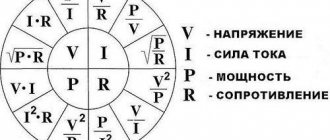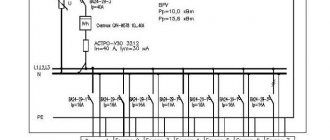Electrical installation - Electrophysical measurements - Power supply
Categories of power supply are formed taking into account the importance of the power consumer! There is industrial power supply or power supply for a private home , and also a power supply project , depending on the importance of the facility! When designing, it is always necessary to remember the rules of power supply - DECISION OF THE COUNCIL OF MINISTERS OF THE REPUBLIC OF BELARUS dated October 17, 2011 No. 1394 Imagine that this is a hospital. After all, designing the power supply for a medical facility or a large manufacturing enterprise takes much more time than designing the power supply for an apartment or house. Yes, the home power supply project should not include emergency situations and various force majeure circumstances. So it turns out that power supply must be divided into categories taking into account the importance of the object.
(Important!) The first category of power supply is power consumers who, as a result of the lack of electricity - respectively downtime, will pose a danger to life, state security, cause major material damage, break down complex and expensive equipment or disrupt a technical process, the operation of communication elements: radio and television. The power supply must be continuous and stable, and also be provided from 2 emergency power sources. Switching between sources should happen as quickly as possible (ideally without downtime)! In industrial power supply, most often there are their own power plants, general power systems - generator voltage buses, various uninterruptible power supply devices, batteries... Designing power supply in this category takes a lot of time, since a detailed plan is drawn up with various calculations and calculations.
(Not unimportant!) The second category of power supply includes the same power consumers as in the first category, but the lack of power supply will not pose a danger to life and health, as well as state security. Public transport powered by electricity can be classified in this group. But if downtime causes major material damage, then this is already the first category of power supply (important!). Power supply must be provided from two independent backup power sources, but some time is allowed for switching. For electricity consumers of the second category, in the event of unforeseen circumstances, time is allowed for elimination and calm restoration of power supply.
The third category of power supply is everything that was not included in the previous important categories. Here, power supply from one source is allowed, provided that after a breakdown it will take no more than 24 hours to restore power supply.
Categorizing the electrical supply in this way allows you to create an electrical design that takes into account the importance! Power supply design allows you to take into account all possible loss scenarios (force majeure circumstances) and calculate the necessary investments to ensure the most acceptable and efficient generation of electricity. If you need a project or electrical supply diagram, contact us!
We invite you to watch “How the process of generating electricity occurs”
Energy reliability category matters
During construction and subsequent conclusion of power supply contracts, in no case should you save money or deviate from the design requirements. This can lead to very unpleasant consequences, including litigation and significant losses.
The following example from judicial practice can serve as clear evidence of this. But first, a little theory.
In accordance with clause 1.4.1 of the Rules for the Use of Electric Energy, approved by Order of the Ministry of Fuel and Energy of the Republic of Belarus dated April 30, 1996 No. 28 (hereinafter referred to as the Rules for the Use of Electric Energy), the essential terms of the contract for the supply of electricity are:
- quantity, timing and quality of electricity to be supplied;
- categorization of the consumer;
- procedure for determining the price of supplied electricity;
- method and conditions for monitoring electricity consumption, indicating the devices by which it will be produced;
- the consumer’s obligation to accept and pay within the established time frame for the amount of consumed electricity stipulated by the contract;
- calculation form;
- the consumer's obligation to ensure the electricity consumption regime established by the contract;
- the number and duration of disconnections of consumers (subscribers) for carrying out scheduled work to repair equipment and connect new consumers, if these consumers (subscribers) do not have backup power;
- the consumer's obligation to allow representatives of the energy supply organization and State Energy Supervision authorities to check the technical means of commercial electricity metering, the condition of the consumer's electrical equipment and electrical installations.
If the parties fail to reach an agreement on essential terms, the electricity supply contract is considered not concluded.
In business practice, cases arise when the parties to an energy supply agreement do not attach due importance to some of the listed essential conditions, in particular the category of the consumer. At the same time, this criterion is one of the most important for ensuring the effective functioning of an enterprise (organization) - the category of an object determines the possibility and duration of interruptions in the supply of electricity by the energy supplying organization. It is clear that if the enterprise (organization) does not have electrical receivers that require uninterrupted power supply, in the event of minor interruptions in the supply of electricity, no significant losses will arise. However, there are such objects, a minimal stop in the operation of their electrical receivers threatens significant losses. These include, for example, elevators, pumps, fire extinguishing systems, etc.
Classification by category of such objects was previously established in the Manual for building codes and regulations P2-2000 to SNiP 2.08.01-89 “Electrical installations of residential and public buildings”, approved by order of the Ministry of Construction and Architecture of the Republic of Belarus dated November 8, 2000 No. 508. From 1 January 2010, TKP 45-4.04-149-2009(02250) “Electrical equipment systems for residential and public buildings” is in effect. Design Rules”, approved by order of the Ministry of Construction and Architecture of the Republic of Belarus dated September 15, 2009 No. 303.
In accordance with clause 2.2 of the Rules for the Use of Electric Energy, categorization of consumer facilities is determined depending on the actual scheme of its power supply. At the same time, TCP 45-4.04-149-2009 establishes the procedure for determining the category and minimum reliability categories for providing power supply to technical fire protection equipment, residential and public buildings, including residential buildings, administrative buildings, design and engineering organizations, research institutes, medical and preventive institutions, financing institutions, lending and state insurance, libraries and archives, educational institutions, trade enterprises, catering and consumer services, hotels, etc.
Degrees of reliability of power supply are divided into 3 categories:
- Category III - emergency power outage is allowed for a period of up to 24 hours;
- Category II - emergency shutdown of power supply is not allowed (power supply is provided from two independent power sources, systems are installed to automatically select a backup power supply line in the event of a power outage);
- Category I - emergency shutdown of power supply is not allowed (power supply is provided from two independent power sources, systems are installed for automatically selecting a backup power supply line in case of outages of one of the lines, in addition, sources of autonomous power supply are installed).
At the same time, according to clauses 5.4.6–5.4.7 of the Rules for the Use of Electric Energy, the energy supplying organization does not bear financial liability to the consumer for the undersupply of electricity caused by the termination of power supply to the consumer within the time limit determined by the category of power supply reliability and a change in the power supply scheme or non-compliance with the category of power supply reliability the consumer through his fault. Thus, if the parties to the contract agreed on a lower categorization of the object than required by the project documentation, responsibility for subsequent losses will fall entirely on the subscriber who signed such an agreement.
Example
The economic court considered the case of the claim of insurance company "B" against RUE "G" for the collection of the principal debt, 968,814 rubles of interest, and a total of 5,441,022 rubles. The third party, who did not make independent claims regarding the subject of the dispute, was ChTPUP “V” on the plaintiff’s side. The third party, who did not make independent claims regarding the subject of the dispute, on the defendant’s side was GUKPP “G”.
In support of the claims presented, the plaintiff referred to Art. 366, 815, 855 of the Civil Code and the obligation of the defendant to reimburse the plaintiff for expenses incurred in connection with the payment of insurance compensation from ChTPUP “V”.
The defendant, in his response to the statement of claim and additions to it, did not admit the claim, referring to the absence of fault in the occurrence of the insured event, as well as to the Rules for the Use of Electrical Energy.
As follows from the case materials, an agreement on voluntary insurance of the property of legal entities was concluded between insurance company “B” and private enterprise “B”, insurance option “E” - failure of the heating system, water supply and sewerage networks, penetration of water from a neighboring premises, unauthorized operation ( breakdown) of fire extinguishing systems. A hotel (a building with finishing and communications) owned by the insured was accepted for insurance.
On February 28, 2008, from 18.40 to 20.05, an insured event occurred - damage to the insured property due to flooding. According to the inspection report of the lost, damaged property, the inspection report of the hotel premises, the damage to the insured property occurred due to the fact that due to an emergency shutdown of the supply of electrical energy to the 10 kW power line and the absence of its supply in the hotel during the period from 18.40 to 20.05 hours on February 28, 2008, there was a stoppage in the operation of the sewage pumping station serving the hotel. The water supply system in the hotel is forced, that is, through pumps creating a pressure of 4.5 MPa. Due to the stop of the pumps, the pressure in the system dropped, the water began to flow into the sewer by gravity, but due to the non-working pump, the sewerage system accumulated in the sewer, and at the junctions of the sewer pipes it leaked and flooded the rooms and office premises of the hotel. As a result, the rooms along the riser in the left wing of the hotel, the premises of the ASB department “B”, service premises in the basement of the hotel - a warehouse, a laundry and staff rest rooms - were flooded. The culprit was not indicated in the inspection report. As a result of the flooding of ChTPUP "B", material damage was caused.
Fulfilling the terms of the insurance contract, the plaintiff paid PCTUP “V” the insurance compensation, as well as remuneration for the implementation of design work to PUP “P”. According to Art. 855 of the Civil Code of the Republic of Belarus (hereinafter referred to as the Civil Code), the insurer who paid the insurance compensation, within the amount paid, transfers the right of claim that the insured (beneficiary) has against the person responsible for the losses compensated as a result of insurance.
In pursuance of the requirements of Part 2, Clause 2, Art. 10 of the Civil Code and the Appendix to the Economic Procedural Code of the Republic of Belarus “Claim procedure for resolving a dispute”, the plaintiff sent a claim to the defendant for the return of the debt. In response to the claim, the defendant refused to satisfy the requirements, citing the absence of his fault in the occurrence of the insured event.
According to the case materials, the cause of the power outage was an emergency. This circumstance is confirmed by the inspection report of the hotel premises, extracts from the emergency shutdown log of RUE “G”, and the operational log of the Distribution Zone. From these documents it follows that the cause of the emergency shutdown was the impact of an unidentified vehicle on reinforced concrete support 6/19 and the resulting breakage of two high-voltage line connections on the said support. According to the entries in these logs, there was no electricity on the damaged external high-voltage network from 18.40 to 20.05 hours on 02.28.2008 for consumers of category III (category I and II - 0 consumers).
The energy supply to the sewage pumping station of ChTPUP “V” is carried out by RUE “G” on the basis of an agreement on the supply of electrical energy. In Appendix No. 2 to the specified agreement the consumer is classified as reliability category III while the parties agreed on the possibility of interruption in power supply in the event of an emergency in the external network lasting up to 24 hours. This circumstance was confirmed at the court hearing by both the defendant and the representative of ChTPUP “V”.
In accordance with clause 2.2 of the Rules for the Use of Electric Energy, the category of consumer objects is determined depending on the actual scheme of its power supply. At the same time, according to clauses 5.4.6–5.4.7 of the mentioned document, the energy supplying organization does not bear financial liability to the consumer for the undersupply of electricity caused by the termination of power supply to the consumer within the time limit determined by the category of power supply reliability.
According to the operating manual (passport) of the electric pump TsMK 16-27 presented by ChTPUP "V", the shutdown of which at the KPS caused the flooding of the hotel, the operating mode of the electric pump is continuous S1 according to GOST 183-74. Thus, taking into account the design features of the sewer system ChTPUP “B”, the need for uninterrupted power supply to the electric pump TsMK 16-27 in the sewer pumping station, the reliability category of the specified consumer should have been determined as II . In the presented project (set of drawings) of a sewerage pumping station of a service center, developed by NIF “I”, it is stipulated that the electrical loads of the SPS belong to category II consumers according to the PUE classification. In addition, as follows from the case materials, the hotel is powered by cable lines from I and II SSh-0.4 kV ZTP-362. ZTP-362 is on the balance sheet of ChTPUP “V”, on the 10 kV side it is connected to two mutually redundant 10 kV overhead lines No. 409 and No. 432 from substation - 35/10. The power supply circuit of both ZTP-362 and the hotel's electrical receivers corresponds to category II in terms of power supply reliability. In the technical specifications sent by the electric networks to ChTPUP “V”, it was agreed to provide power to the consumer in the amount of 185 kV in 2007, including reliability category I - 30 kV, and category II - 155 kV, category III - 0 kV.
At the same time, having signed an agreement on the supply of electrical energy with Republican Unitary Enterprise "G", ChTPUP "V" agreed with the classification of the facility into the III reliability category and the possibility of emergency shutdown of power supply lasting up to 24 hours. In accordance with Art. 391 of the Civil Code, citizens and legal entities are free to enter into an agreement. In accordance with Art. 401 of the Civil Code, when interpreting the terms of a contract, the court takes into account the literal meaning of the words and expressions contained in it.
As a reason for concluding an agreement for the III category of reliability, the representative of private enterprise "B" named in the court hearing the presence of only one employee in the company's staff responsible for power supply, and the impossibility of ensuring the presence of this employee at the enterprise around the clock, including in the evening, at night and on weekends days to switch power sources, and the lack of automatic backup devices. The contract with RUE “G” for the operational and technical maintenance of ZTP-362 and overhead line-10 kV with a length of 1.956 km was concluded by ChTPUP “V” only on 02/01/2010.
In accordance with clause 12.5.2 of the Rules for voluntary insurance of property of legal entities No. 21, approved by BRUSP "Belgosstrakh" and agreed with the Ministry of Finance of the Republic of Belarus on July 11, 2006 No. 671, the policyholder is obliged to ensure the normal operation of the heating system, water supply and sewerage networks in the premises, being the place of insurance, their timely maintenance and repair. The specified actions of ChTPUP “B” regarding the timely switching of the power supply source or the conclusion of an agreement on the supply of electrical energy with the classification of the facility into reliability category II were not carried out.
In connection with the above, the court came to the conclusion that the defendant was not at fault for turning off the power supply to the sewerage pumping station of ChTPUP “V”, since the duration of this emergency situation was within the limits agreed upon by ChTPUP “V” and the defendant in the contract for the supply of electrical energy.
The plaintiff did not present convincing evidence to the contrary to the court. In accordance with Art. 100 of the Economic Procedural Code of the Republic of Belarus, each person participating in the case must prove the circumstances to which he refers as the substantiation of his claims and objections, unless otherwise provided by law. Evidence that the plaintiff has the right to claim against the defendant in accordance with Art. 855, 933 of the Civil Code by the plaintiff was not presented to the court.
In connection with the above, the claims were denied.
In addition, the court sent a special ruling to the parties under the energy supply agreement, indicating to them the need to bring the contractual legal relationship between RUP “G” and ChTPUP “V” in accordance with the actual category of the subscriber’s power-consuming devices.
How to choose a BKTP based on the category of power supply reliability?
The “Electrical Installation Rules” (PUE) divide all electrical receivers into three categories from the point of view of reliability of power supply. The category of the power receiver is determined at the design stage of the facility and depends on the consequences that could result from an interruption in power supply.
For each reliability category, it can offer several solutions; the main options are shown in the table:
| Electricity category | Requirements for the power source according to the PUE | Solution |
| Third category | For electrical receivers of the third category, power supply can be provided from a single power source, provided that power supply interruptions necessary to repair or replace a damaged element of the power supply system do not exceed 1 day (PUE 1.2.21) | For the third category of power supply, it is enough to use a single-transformer substation. This can be a compact KTP-B without service corridors or a classic single-block BKTP. |
| Second category | Electrical receivers of the second category in normal operating modes must be provided with electricity from two independent mutually redundant power sources (PUE 1.2.20) | The most common option for power supply to consumers of the second category is a two-transformer BCTP (2BCTP). If there is no second network input, then power supply in the second category can be provided using 1BCTP with a diesel generator set. |
| First category | Electric receivers of the first category in normal operating modes must be provided with electricity from two independent mutually redundant power sources, and an interruption in their power supply […] can only be allowed for the period of automatic power restoration (PUE 1.2.19) | For electrical receivers of the first category, as a rule, a two-transformer BKTP (2BCTP) is used. At the same time, to ensure automatic power restoration, for consumers of the first category, an automatic transfer switch device (ATS) is provided. As a rule, the ATS is installed directly in the facility's input switchgear (ASD). In addition, upon request, it produces 2 BCTP with an ATS on the 0.4 side kV and/or with AVR of 10 kV. |
| A special group of consumers of the first category | To supply power to a special group of electrical receivers of the first category, additional power must be provided from a third independent mutually redundant power source (PUE 1.2.19) | For this group of consumers, either a three-transformer BKTP or a 2-BKTP with an additional power source is required. manufactures 2BKTP with DGU - a two-transformer BKTP combined with a diesel generator set, meeting the requirements of a special group of the first category. |
You can download standard BKTP designs for free in our library. If you have not found a suitable project, ask us a question and within one working day you will receive specialist advice.
To the list of questions
Categories for ensuring the reliability of electrical installations
To understand what the instructions for power supply to residential buildings mean, you first need to be informed about three categories related to ensuring the reliability of power supply to electrical installations.
Note that one of the simplest is the third category. It involves power supply to a residential building from a substation using just one electric power. cable. In the event that an emergency occurs, the total interruption time in providing power to the house should be about a day (or less). Second category: the house is “equipped” with two electric. cables, which, in turn, are connected to various transformer substations. If the transformer itself breaks down or one of the cables is damaged, further power supply to the residential building occurs using a backup cable. An interruption in power supply is only equal to the time that is necessary for the craftsmen to redistribute the entire load onto the working cable. All standards and rules observed in the design of electrical supply are available in the Construction Code for Electrical Supply of Residential Buildings.
Electrical supply for residential buildings: sample
Back
Forward
There are two types of power supply to a residential building from two different transformer substations. First scheme: the total load is evenly distributed across all transformers. In the event of an emergency, all substations are connected to one cable, or in normal mode one cable is used, while the second serves as a backup. However, in all options the cables are directed to different substations. In the event that 2 cables are laid in the electrical panel of a residential building (and one of them is a backup), but there is a real possibility of connecting these cables to one single transformer, then we are talking about the third category of reliability, which was described at the beginning of the article.
In the first category, the house has two cables. But in the event of a transformer (or cable) failure, the total load of the residential building is connected to another cable operating normally using an ATS (automatic transfer switch device). Let's talk about a special group of so-called electrical receivers. These include smoke removal systems, evacuation lighting systems, etc. Electrical receivers must operate only in the 1st category. Backup power sources are either small electric ones. stations, or special batteries.
Based on state standards, the third reliability category includes houses with gas stoves and no more than 5 storeys; houses with electric stoves with a total number of apartments < 9; houses of various associations.
Second price category of electricity
The optimal price category for those who work only at night.
The electricity tariff depends on the time of day:
- Day and night.
- or Peak, Half Peak and Night.
You can choose for yourself which option suits you best.
Electricity cost calculation =
night tariff for electricity * consumption according to the meter at night
+ daily electricity tariff * consumption by meter during the day
Conditions:
- power up to 670 kW
- multi-tariff meter that keeps records by day zones
Advantages: Optimal tariff for small organizations with a night work schedule.
Flaws:
- Very high price for electricity during the day.
- Calculation for power occurs on the residual principle.
- Not suitable for organizations that work day and night.
The second price category is suitable for organizations that work only at night, such as bakeries, or for organizations that can completely switch to a night work schedule.
An example of cost calculation for the second price category is at the link.











